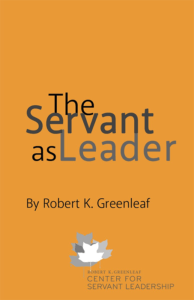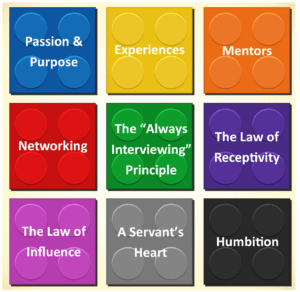 For part 8 of 9 in our Building Blocks of Your Career Series, we will delve into the importance of “A Servant’s Heart.” In his very powerful essay, The Servant as Leader, Robert K. Greenleaf is credited to have coined the term “servant leader.” He is equally credited with describing some of the characteristics, behaviors and activities that define true servant leaders.
For part 8 of 9 in our Building Blocks of Your Career Series, we will delve into the importance of “A Servant’s Heart.” In his very powerful essay, The Servant as Leader, Robert K. Greenleaf is credited to have coined the term “servant leader.” He is equally credited with describing some of the characteristics, behaviors and activities that define true servant leaders.
In reading a brief summary of Greenleaf’s essay, published in 1970, I found some key points that I believe are “career building” components worth expanding on. These include:
Awareness
- Awareness of need or opportunity: noticing the opportunity to stand in the gap, pick up the slack or help get the job done are classic phrases that first require awareness. Want someone to you in your career? First take notice of opportunities to make a difference. Go above and beyond because you believe it is the right thing to do, not because you’ve been told by a supervisor to do it. Another classic term often heard in this area is, “show some initiative.” This is a good thing of course, but to show initiative, one must first become aware of what needs to be done to display the outcome of the initiative.
- Awareness of one’s capacity: a classic way of looking at this concept is knowing one’s strengths and weaknesses. If someone is aware of a need or an opportunity, but doesn’t have the capacity (and required skills) to fill the need or fix the problem, the need will not be filled well. However, if this same individual has the capacity to meet the need, one might suggest they have the responsibility to step up.
- Awareness of one’s impact: I see this one as a means of personal inspiration and professional satisfaction. Paying attention to the good we do for our team, our facility and our community, gives us a good shot of happy chemicals like oxytocin and serotonin, and these feelings motivate us in a healthy way to do more good. When others observe our servant’s heart-based actions, it’s been scientifically proven to boost the same chemicals in their bodies so they are inspired to do what they’ve observed or similar.
- Awareness of the value of 360° feedback: similar to impact above, our ability to ask for and receive constructive feedback (in a 360° view) from those we lead, serve and coach is highly valuable for any professional. Modeling this ability to receive is yet another way in which we can separate ourselves from the pack, all the while becoming more aware of how we can positively affect others.
 Foresight (this is similar to awareness, but the focus is generally on the future)
Foresight (this is similar to awareness, but the focus is generally on the future)
- Foresight to anticipate: seeing the need, the opportunity or similar that is coming; and best of all, preparing to be ready to fill it when it comes.
- Foresight to avoid: seeing pitfalls and landmines is a key aspect of a leader with a servant’s heart. A servant’s heart is willing to invest effort and emotional intelligence, showing concern for others (even if it requires having difficult conversations) in order to help them avoid a pitfall.
- Foresight to inspire and motivate: with a servant heart, a leader can work ahead to prepare a platform for their team to perform, get desired results and come together in a way that fuels the team to work better on long term goals and vision.
Listening (this is the key behavior required for awareness and foresight)
- Listening to understand: paying attention to what people are saying, and what they are not saying. What are their non-verbals really saying? With a servant’s heart, understanding is for the benefit of who is being served, lead or similar. This includes:
- Listening to support
- Listening to propel (so you can nudge them forward)
- Listening to gain valuable feedback (in order to learn more, understand better)
- Dan Price, (the CEO and founder of Gravity Payments, a credit-card processing company that supports independent businesses) wrote the following steps to become a servant leader:
- “Instead of spending your time defining expectations for your team, spend it identifying how you can support them.”
- “Have your team keep an eye on your actions rather than the other way around.”
- “Ask for feedback rather than telling your team what to do.”
- “Resist the urge to accumulate power. Focus on giving it away.”
Power (the appropriate use, application of one’s power)
- Coercive Power: the power based on authority. “You need to do this/that, because I said so…or else.” When we’re building our career, we are often given the chance to supervise, lead and/or direct others. If we’ve been mentored by someone who coerced us (and our co-workers) to get things done, it will be very easy for us to coerce (or compel) others to do the same.
- Manipulative Power: this power is also based on authority, but can be the “uglier side” of coercion. Combining rank and/or authority, the needs of the person with the authority come first and often, the emotions of those who are manipulated a played upon.
- Persuasive Power: this power is not always based on authority or rank, but can be as well. Instead of compulsion, it relies on persuasion, or the art of convincing. When used appropriately, it can be mutually beneficial for the one who is “being persuaded” as well as the persuader. When it’s not mutually beneficial, it’s generally like my father’s analogy when calling a hammer a “persuader.” In this case, the hammer either pounds in the nail, bends it back to straight or similar.
- “Loaned” Power: this is the best kind of power, and it is generally applied for the purpose of cultural, team or the mutual benefit of all. It’s power that is given by choice “on loan” from those who follow a leader based on that leader having and modeling a “servant’s heart.” Those who give this loaned power don’t have to either; they give it by choice. They give it after it has been earned by the leader who has proven (over and over) how much they care, how much they are willing to sacrifice. This is the power given (not taken) by those “Leaders (who) Eat Last.” Learn more about this concept in a summary by the 12min Blog team of Simon Sinek’s book, Leaders Eat Last.
So, how is the beat of your “servant’s heart?” Last year was certainly a season of challenge and one that put every professional’s heart for service under pressure. For some, it may have been too much. For so many others, that servant’s heart got stronger. Just like a human heart, the servant’s heart is like a muscle…it gets stronger with intentional use and training. I hope you will join me so we can train (our servants’ hearts) together.
Monte Koch, PGA Certified Professional/Player Development | Career Consultant
PGA Career Services | PGA of America
Serving PGA professionals, employers in the Pacific NW & Rocky Mountain PGA Sections
Email: Mkoch@pgahq.com Cell: 206/335-5260
Lea Hill, WA | My LinkedIn | My Professional Blog
Click HERE to Begin Our New Career Planning Program